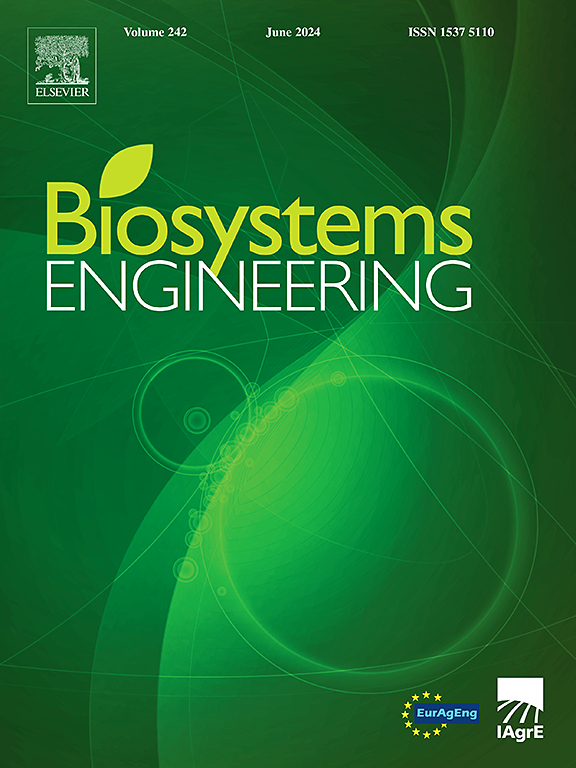大豆在压缩载荷作用下的破裂松弛特性模拟
IF 4.4
1区 农林科学
Q1 AGRICULTURAL ENGINEERING
引用次数: 0
摘要
本研究评估了大豆品种(P23A40E、XF31-32N和EL30-33)的机械压缩行为,以优化榨油过程中的能量利用。研究了初始压高(20、30和50 mm)和加载速率(20、30和50 mm min−1)以及变化对破裂、变形和松弛行为的影响。压缩试验分别使用配备5kn和25kn称重传感器的TestResources通用试验机对单粒大豆和散装大豆进行。采用数学模型对大豆在压缩条件下的载荷变形和松弛特性进行了表征。结果表明,试样种类、初始压紧高度和加载速率对断裂能和弹性模量有显著影响(p <;0.05)。随着加载速率和初始压紧高度的增大,各品种的断裂能增大,弹性模量减小。tan模型(1-3阶)有效地描述了载荷变形特性,而Peleg和Normand模型提供了一种可访问的方法来模拟松弛行为,呈现RMSE <;0.0058。Maxwell标准线性实体(SLS)模型有效地模拟了压缩和松弛阶段的应力动态。总的来说,这些模型提供了对负载需求、能量损失缓解和质量维护的见解,对扩大基于压缩的豆油生产具有重要意义。研究表明,根据品种特性选择最佳加载参数可提高能源效率和产油量。这种全面的方法促进了对压缩下大豆行为的理解,使更高效、更注重质量的榨油过程成为可能。本文章由计算机程序翻译,如有差异,请以英文原文为准。
Modelling rupture and relaxation characteristics of soybean under compressive loading
This study evaluates the mechanical compression behaviour of soybeans varieties (P23A40E, XF31-32N, and EL30-33) for optimal energy usage in oil extraction. The influence of initial pressing height (20, 30, and 50 mm) and loading rate (20, 30, and 50 mm min−1), and variety on rupture, deformation and relaxation behaviours were investigated. Compression tests were performed using a TestResources universal testing machine equipped with 5 kN and 25 kN load cells for single kernel and bulk soybeans, respectively. Mathematical models were used to characterize the load-deformation and relaxation properties of soybeans under compression. Results showed that variety, initial pressing height, and loading rate significantly affected rupture energy and modulus of elasticity (p < 0.05). Rupture energy increased while modulus of elasticity decreased with higher loading rates and initial pressing heights across varieties. The Tangent model (order 1–3) effectively described load-deformation characteristics, while the Peleg and Normand model provided an accessible method to model relaxation behaviour, presenting an RMSE <0.0058. The Maxwell Standard Linear Solid (SLS) model effectively simulated stress dynamics over compression and relaxation stages. Collectively, these models offer insights into load requirements, energy loss mitigation, and quality maintenance, with implications for scaling up compression-based soybean oil production. The study concludes that selecting optimal loading parameters based on variety-specific characteristics improves energy efficiency and oil yield. This comprehensive approach advances understanding of soybean behaviour under compression, enabling more efficient, quality-focused oil extraction processes.
求助全文
通过发布文献求助,成功后即可免费获取论文全文。
去求助
来源期刊

Biosystems Engineering
农林科学-农业工程
CiteScore
10.60
自引率
7.80%
发文量
239
审稿时长
53 days
期刊介绍:
Biosystems Engineering publishes research in engineering and the physical sciences that represent advances in understanding or modelling of the performance of biological systems for sustainable developments in land use and the environment, agriculture and amenity, bioproduction processes and the food chain. The subject matter of the journal reflects the wide range and interdisciplinary nature of research in engineering for biological systems.
 求助内容:
求助内容: 应助结果提醒方式:
应助结果提醒方式:


